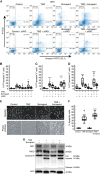Patient-derived glioblastoma cells show significant heterogeneity in treatment responses to the inhibitor-of-apoptosis-protein antagonist birinapant
- PMID: 26657652
- PMCID: PMC4815807
- DOI: 10.1038/bjc.2015.420
Patient-derived glioblastoma cells show significant heterogeneity in treatment responses to the inhibitor-of-apoptosis-protein antagonist birinapant
Abstract
Background: Resistance to temozolomide (TMZ) greatly limits chemotherapeutic effectiveness in glioblastoma (GBM). Here we analysed the ability of the Inhibitor-of-apoptosis-protein (IAP) antagonist birinapant to enhance treatment responses to TMZ in both commercially available and patient-derived GBM cells.
Methods: Responses to TMZ and birinapant were analysed in a panel of commercial and patient-derived GBM cell lines using colorimetric viability assays, flow cytometry, morphological analysis and protein expression profiling of pro- and antiapoptotic proteins. Responses in vivo were analysed in an orthotopic xenograft GBM model.
Results: Single-agent treatment experiments categorised GBM cells into TMZ-sensitive cells, birinapant-sensitive cells, and cells that were insensitive to either treatment. Combination treatment allowed sensitisation to therapy in only a subset of resistant GBM cells. Cell death analysis identified three principal response patterns: Type A cells that readily activated caspase-8 and cell death in response to TMZ while addition of birinapant further sensitised the cells to TMZ-induced cell death; Type B cells that readily activated caspase-8 and cell death in response to birinapant but did not show further sensitisation with TMZ; and Type C cells that showed no significant cell death or moderately enhanced cell death in the combined treatment paradigm. Furthermore, in vivo, a Type C patient-derived cell line that was TMZ-insensitive in vitro and showed a strong sensitivity to TMZ and TMZ plus birinapant treatments.
Conclusions: Our results demonstrate remarkable differences in responses of patient-derived GBM cells to birinapant single and combination treatments, and suggest that therapeutic responses in vivo may be greatly affected by the tumour microenvironment.
Figures






Similar articles
-
NVP-BEZ235, a novel dual PI3K-mTOR inhibitor displays anti-glioma activity and reduces chemoresistance to temozolomide in human glioma cells.Cancer Lett. 2015 Oct 10;367(1):58-68. doi: 10.1016/j.canlet.2015.07.007. Epub 2015 Jul 15. Cancer Lett. 2015. PMID: 26188279
-
Inhibition of GSH synthesis potentiates temozolomide-induced bystander effect in glioblastoma.Cancer Lett. 2013 Apr 30;331(1):68-75. doi: 10.1016/j.canlet.2012.12.005. Epub 2012 Dec 12. Cancer Lett. 2013. PMID: 23246370
-
Smac mimetic Birinapant induces apoptosis and enhances TRAIL potency in inflammatory breast cancer cells in an IAP-dependent and TNF-α-independent mechanism.Breast Cancer Res Treat. 2013 Jan;137(2):359-71. doi: 10.1007/s10549-012-2352-6. Epub 2012 Dec 7. Breast Cancer Res Treat. 2013. PMID: 23225169
-
An Interplay between Senescence, Apoptosis and Autophagy in Glioblastoma Multiforme-Role in Pathogenesis and Therapeutic Perspective.Int J Mol Sci. 2018 Mar 17;19(3):889. doi: 10.3390/ijms19030889. Int J Mol Sci. 2018. PMID: 29562589 Free PMC article. Review.
-
Cell death in glioblastoma and the central nervous system.Cell Oncol (Dordr). 2025 Apr;48(2):313-349. doi: 10.1007/s13402-024-01007-8. Epub 2024 Nov 6. Cell Oncol (Dordr). 2025. PMID: 39503973 Free PMC article. Review.
Cited by
-
Voltage-gated ion channels mediate the electrotaxis of glioblastoma cells in a hybrid PMMA/PDMS microdevice.APL Bioeng. 2020 Jul 1;4(3):036102. doi: 10.1063/5.0004893. eCollection 2020 Sep. APL Bioeng. 2020. PMID: 32637857 Free PMC article.
-
System-based approaches as prognostic tools for glioblastoma.BMC Cancer. 2019 Nov 12;19(1):1092. doi: 10.1186/s12885-019-6280-2. BMC Cancer. 2019. PMID: 31718568 Free PMC article. Review.
-
The role of E3 ubiquitin ligases in the development and progression of glioblastoma.Cell Death Differ. 2021 Feb;28(2):522-537. doi: 10.1038/s41418-020-00696-6. Epub 2021 Jan 11. Cell Death Differ. 2021. PMID: 33432111 Free PMC article. Review.
-
A reference collection of patient-derived cell line and xenograft models of proneural, classical and mesenchymal glioblastoma.Sci Rep. 2019 Mar 20;9(1):4902. doi: 10.1038/s41598-019-41277-z. Sci Rep. 2019. PMID: 30894629 Free PMC article.
-
Molecular subtype-specific responses of colon cancer cells to the SMAC mimetic Birinapant.Cell Death Dis. 2020 Nov 30;11(11):1020. doi: 10.1038/s41419-020-03232-z. Cell Death Dis. 2020. PMID: 33257690 Free PMC article.
References
-
- Allensworth JL, Sauer SJ, Lyerly HK, Morse MA, Devi GR (2013) Smac mimetic birinapant induces apoptosis and enhances TRAIL potency in inflammatory breast cancer cells in an IAP-dependent and TNF-alpha-independent mechanism. Breast Cancer Res Treat 137: 359–371. - PubMed
-
- Baysan M, Woolard K, Bozdag S, Riddick G, Kotliarova S, Cam MC, Belova GI, Ahn S, Zhang W, Song H, Walling J, Stevenson H, Meltzer P, Fine HA (2014) Micro-environment causes reversible changes in DNA methylation and mRNA expression profiles in patient-derived glioma stem cells. PLoS One 9: e94045. - PMC - PubMed
-
- Benetatos CA, Mitsuuchi Y, Burns JM, Neiman EM, Condon SM, Yu G, Seipel ME, Kapoor GS, Laporte MG, Rippin SR, Deng Y, Hendi MS, Tirunahari PK, Lee YH, Haimowitz T, Alexander MD, Graham MA, Weng D, Shi Y, McKinlay MA, Chunduru SK (2014) birinapant (TL32711), a bivalent SMAC mimetic, targets TRAF2-associated cIAPs, abrogates TNF-induced NF-kappaB activation, and is active in patient-derived xenograft models. Mol Cancer Ther 13: 867–879. - PubMed
Publication types
MeSH terms
Substances
LinkOut - more resources
Full Text Sources
Other Literature Sources
Medical
Molecular Biology Databases
Research Materials
Miscellaneous

